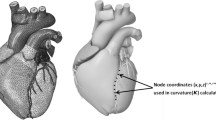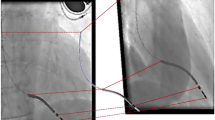Abstract
To minimize time-consuming and expensive in vitro and in vivo testing, information regarding the effects of implantation and the implants on measurements should be available during the designing of active implantable devices measuring bioelectric signals such as electrocardiograms (ECG). Modeling offers a fairly inexpensive and effective means of studying and demonstrating the effects of implantation on ECG measurements prior to any in vivo tests, and can thus provide the designer with valuable information. Finite difference model (FDM) and lead field approaches offer straightforward and effective modeling methods supporting the designing of active implantable ECG devices. The present study demonstrates such methods in developing and studying ECG implants. They were applied in demonstrating the effects of implant dimensions and of electrode implantation on the measurement sensitivity of the ECG device. The results of the simulations indicated that the interelectrode distance is the factor of the implant design determining the lead sensitivity. Other parameters related implant dimensions and shape have minor effect on the morphology of the ECG or on the average sensitivity of the measurement. This is shown for example when the interelectrode distance was reduced to 1/3 of original the average lead sensitivity decreased by 69.1% while larger relative changes in other dimensions produced clearly smaller changes. It was also observed here that implanting the electrodes deeper under the skin has major effects on the local sensitivities in heart muscle and thus affect to the morphology of the ECG. The study indicated also that non-conducting medium (i.e. implant insulated body) between the electrodes increases the sensitivity on heart muscle compared to cases where only electrodes are implanted.



Similar content being viewed by others
References
Ackerman MJ (1991) The Visible Human Project. J Biocommun 18(2):14
Boersma L, Mont L, et al (2004) Value of the implantable loop recorder for the management of patients with unexplained syncope. Europace 6(1):70–76
Carter EL Jr, Pollack SR, et al (1990) Theoretical determination of the current density distributions in human vertebral bodies during electrical stimulation. IEEE Trans Biomed Eng 37(6):606–614
Chrysostomakis SI, Klapsinos NC, et al (2003) Sensing issues related to the clinical use of implantable loop recorders. Europace 5(2):143–148
Farwell DJ, Freemantle N, et al (2004) Use of implantable loop recorders in the diagnosis and management of syncope. Eur Heart J 25(14):1257–1263
Ferdjallah M, Bostick FX Jr, et al (1996) Potential and current density distributions of cranial electrotherapy stimulation (CES) in a four-concentric-spheres model. IEEE Trans Biomed Eng 43(9):939–943
Gabriel S, Lau RW, et al (1996) The dielectric properties of biological tissues: II. Measurements in the frequency range 10 Hz–20 GHz. Phys Med Biol 41(11):2251–2269
Hyttinen J (1994) Development of regional aimed ECG leads especially for myocardial ischemia diagnosis. Ragnar Granit Institute. Tampere, Tampere University of Technology, p162
Hyttinen JAK, Malmivuo JA, Walker SJ (1993) Lead field of ECG leads calculated by a computer thorax model-an application of reciprocity. In: Proceedings of the Computers in cardiology, 5–8 September 1993, pp 241–244
Johnson CR (1997) Computational and numerical methods for bioelectric field problems. Crit Rev Biomed Eng 25(1):1–81
Jorgenson DB, Haynor DR, et al (1995) Computational studies of transthoracic and transvenous defibrillation in a detailed 3-D human thorax model. IEEE Trans Biomed Eng 42(2):172–184
Kauppinen P, Hyttinen J, et al (1998) Detailed model of the thorax as a volume conductor based on the visible human man data. J Med Eng Technol 22(3):126–133
Kauppinen P, Hyttinen J, et al (1999) A software implementation for detailed volume conductor modelling in electrophysiology using finite difference method. Comput Methods Programs Biomed 58(2):191–203
Klepfer RN, Johnson CR, et al (1997) The effects of inhomogeneities and anisotropies on electrocardiographic fields: a 3-D finite-element study. IEEE Trans Biomed Eng 44(8):706–719
Krasteva VT, Papazov SP (2002) Estimation of current density distribution under electrodes for external defibrillation. Biomed Eng Online 1(1):7
Laarne P, Eskola H, et al (1995) Validation of a detailed computer model for the electric fields in the brain. J Med Eng Technol 19(2–3):84–87
Laarne P, Hyttinen J, et al (2000) Accuracy of two dipolar inverse algorithms applying reciprocity for forward calculation. Comput Biomed Res 33(3):172–185
Malmivuo J, Plonsey R (1995) Bioelectromagnetism: principles and applications of bioelectric and biomagnetic fields. Oxford University Press, New York
Panescu D, Webster JG, et al (1994) Modeling current density distributions during transcutaneous cardiac pacing. IEEE Trans Biomed Eng 41(6):549–555
Papazov S, Kostov Z, et al (2002) Electrical current distribution under transthoracic defibrillation and pacing electrodes. J Med Eng Technol 26(1):22–27
Riistama J, Väisänen J, et al (2005) Introducing a wireless, passive and implantable device to measure ECG. In: IFMBE proceedings of the third European Medical and Biological Engineering Conference, IFMBE, Prague
Sachse FB (2004) Computational cardiology: modeling of anatomy electrophysiology, and mechanics. Springer, Berlin
Song Z, Jenkins J, et al (2004) The feasibility of ST-segment monitoring with a subcutaneous device. J Electrocardiol 37(Suppl 1):174–179
Takano N (2002) Reduction of ECG leads and equivalent sources using orthogonalization and clustering techniques. Ragnar Granit Institute. Tampere, Tampere University of Technology, p302
Vehkaoja A, Lekkala J (2004) Wearable wireless biopotential measurement device. In: Proceedings of the 26th annual international conference of EMBC 2004, vol 3, pp 2177–2179. Engineering in Medicine and Biology Society
Vaisanen J, Hyttinen J, Puurtinen M, Kauppinen P, Malmivuo J (2004) Prediction of implantable ECG lead systems by using thorax models. In: Proceedings of the 26th annual international conference of EMBC 2004, vol 2, pp 809–812. Engineering in Medicine and Biology Society
Acknowledgements
We would like to thank PhD Noriyuki Takano for providing the finite different method software. We would also like to thank MSc Tuukka Arola for providing the visualization tools. This work has been part of WIRELESS-project (5205437) funded by the Academy of Finland. The work has been supported also by the grants from the Finnish Cultural Foundation and the Ragnar Granit Foundation.
Author information
Authors and Affiliations
Corresponding author
Rights and permissions
About this article
Cite this article
Väisänen, J., Hyttinen, J. & Malmivuo, J. Finite difference and lead field methods in designing implantable ECG monitor. Med Bio Eng Comput 44, 857–864 (2006). https://doi.org/10.1007/s11517-006-0092-7
Received:
Accepted:
Published:
Issue Date:
DOI: https://doi.org/10.1007/s11517-006-0092-7




